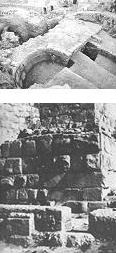Nea Church, 543 CE
“In June 1970, preparations were being made for the construction of a dwelling in the court of the Batei Mahse, near the Rothschild House. This complex, founded in the previous century by Jews from Germany, centered around a large courtyard popularly called “Der Deutscher Platz.” A Hebrew newspaper of over a century ago (Hamagid, 1862) relates how an ancient wall was discovered during the digging of the foundation for the Batei Mahse. The wall, built of very large stones, was discovered together with a marble pavement. Conrad Schick, the Swiss architect who resided in Jerusalem at that time, also reported this find.” The wall was found to be part of the Nea Church.
In 1976-77, the southern supporting wall of the Nea Church was found, which led archaeologists to be able to estimate the overall width of the church to be 105 meters.
In January 1982, The southern internal apse of the Nea church was uncovered during construction work near the Turkish city wall.
Nea Church Inscription
A Greek inscription molded in plaster found in the excavation of the Nea commemorates the completion of the church in 543 C.E. It was found in a cistern of the Nea Church and states that “this work too was donated by our most pious Emperor Flavious Justinian.” In addition to praising Justinian for carrying out the project, it also mentions that Constantinus, the abbot of the church’s monastery, supervised the work. The inscription was carefully framed by a tabula ansata with its flanking triangular handles. A more detailed description of the church appears in the sixth-century account of the Byzantine court historian Procopius.
Avigad, Nahman, Discovering Jerusalem, Shikmona Publishing Co, Jerusalem, 1980, p. 230-234.
“Found After 1400 Years—The Magnificent Nea,” BAR, Dec 1977.
Taylor, Joan, “The Nea Church; Were the Temple Treasures Hidden Here?” BAR, Jan-Feb 2008.
Israel Museum
See also-






I spent a few weeks looking for relevant remarks on that subject, and
this one works! I am sure your reasons to ask
for help were similar to mine. The toughest year in uni has been my third year.
Oh guy, I remember these hard times, this workload and also these sleepless nights!
Thankfully to my roommate, who advised me to search for extra help
at https://essayhub.com, those guys appeared real pros.
I ordered some experiments, and they had been finished at TWO DAYS!
Still can not comprehend just how did they do this, but I obtained 98 POINTS for every!!!
Earth shattering help and second help from the experts of Printer Helpers. This previous Tuesday, my Epson printer out of nowhere shows an affiliation network bungle then this current association’s staff settle all blunders rapidly and produces mind boggling results. Appreciative to You! https://printerhelpers.com/
Is your Canon MG2900 Printer not responding? If yes, then there can be several reasons for the issues. In this section, let’s check out the cause of the issue. The major cause for the issue is a poor internet connection, server issues, outdated printer driver, or incompatible Windows versions. These are common reasons why users encounter Canon printers not responding to issues. Now when you know the cause of the issue, you can deal with it smoothly without any issue. Follow the troubleshooting steps properly to use the Canon printer without any interruption.
Thanks for your post. Recently I start writing an essay and I don`t have time that writes it. But a friend helped me and show a blog https://writemypapers.company/edit-my-paper/ that after reading I understand several tips and I wanna recommend it to you due to because if you won’t write about your sings more
good article
A good article, she encouraged me to write quality blogs. But when I write a blog I use Editius which allows me to put my thoughts together. It helps me to complement my blog and add a variety of thoughts. So I get new ideas for writing. When I read your article, I realized that I need to reconsider some aspects in writing my blog.